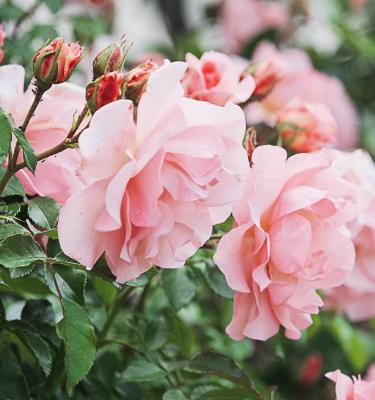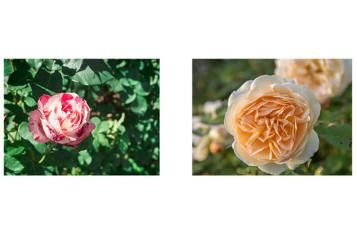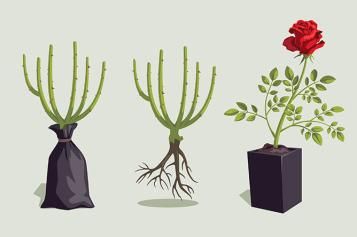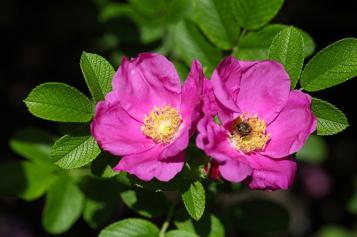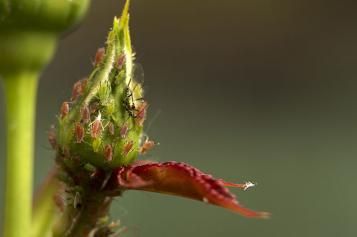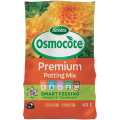The rose is said to be the world's most popular flower - that's why it's called the 'Queen of Flowers'.
There are thousands of magnificent rose varieties available today have their origins in the 150 or so species that grow wild throughout the northern hemisphere - from Alaska to Mexico and northern Africa.
Universally admired for their beautiful blooms and luxuriant growth, they thrive across widely varying climates and soils, from warm coastal gardens of sandy loam to cool high country rocky terrain.
When to plant roses in New Zealand:
- Full sun for at least six to eight hours a day.
- A good loamy soil with plenty of organic matter included to retain moisture.
- Good drainage - they don't like 'wet feet'.
- A slightly acidic soil with a pH around 6.5.
- Shelter from strong winds that could 'smash' blooms.
Choosing a rose right for you
Today, rose flowers range from pure white through every hue and shade to deep crimson and purple-black.
The form of the blooms is just as varied - from the simple circle of petals of the original species roses through to the dense heads of petals of the modern hybrids.
There's at least one to suit every taste!
What type of rose is best for you?
Popular roses are:
- Species
- Heritage (old fashioned)
- Floribunda (multiple flowers on a stem)
- Hybrid Tea (single stem or exhibition bloom)
- Standard (grown on a tall single trunk)
- Climber / Rambler (long stems that can be trained up a frame)
- Miniature (dwarf plants and flowers)
There are also many sub groups within these, such as the Delbard 'Painted Rose' series with their outlandishly striped petals and the David Austin roses - modern roses in the old-fashioned style.
Top tip
Using catalogues or books to work out what roses you would like to add to your garden is not always the best idea. Printing processes can alter colours and the actual sizes of plants and flowers can be hard to determine from photos.
When you're on the look-out for new roses, visit rose shows or rose display gardens to see the plants or flowers 'in the flesh' before making decisions.
When to buy roses?
- Roses are deciduous - This means that they lose their leaves and go into a dormant state during the colder months of the year. Rose plants may be without leaves for several months from late autumn through to early spring (May to September) in cool and temperate climates.
Roses in the nursery
- Traditionally, roses are lifted from the growing beds in nurseries and sold 'bare-rooted' during winter.
- Winter is the ideal time to buy roses - because they are dormant, their normal growing cycle isn't interrupted by lifting and then replanting.
- Though modern nursery practices now see roses available all year round - bare-rooted in winter and in pots through the rest of the year. It's possible to buy a potted rose in flower, so you can see exactly what you're going to get!
How to plant bare-rooted roses?
On sale over winter, bare-rooted roses may have their roots wrapped in damp sawdust and plastic to stop them drying out, or they may be temporarily 'planted' into boxes of sawdust at the retailer's.
Once you get your new rose home, it's important to plant it as soon as possible.
Step 1
Prepare a planting hole that will comfortably hold the roots without restriction.
Step 2
Add some Compost & Soil Improver and mix it through the soil in the base of the hole.
DO NOT add fertiliser to the soil when planting a bare-rooted rose. INSTEAD wait until the first signs of new leaves in spring and then apply a quality rose fertiliser at the rate recommended on the pack.
Step 3
Check the depth of the hole - make sure the rose will not be planted deeper than it was in the nursery. The graft or bud should be well clear of the eventual soil level - look for the old soil mark on the stem.
Step 4
Form a small mound in the centre of the hole - position the plant so it sits on the mound and its roots fan out and point downwards.
Step 5
Backfill with good quality soil, such as Scotts Osmocote Rose, Gardenia, Azalea & Camellia Mix, making sure to fill in around the roots to remove air pockets.
Step 6
Firm the soil but do not pack it down.
Step 7
Water well to settle the soil.
Growing roses in pots
Potted roses are available for sale from spring through to autumn. Potted roses will provide instant colour in the garden.
NOTE: You can grow roses in pots permanently, especially mini roses. When growing roses in pots, choose a pot size and style that's appropriate and always use a premium quality potting mix.
Step 1
Prepare the planting hole as you would for a bare-rooted rose but without the mound in the base.
Step 2
Add a rose food and work it into the soil in the base of the hole so it won't be in direct contact with the roots.
Step 3
Check the depth - the rose plant should be at the same depth as it is in the pot.
Step 4
Carefully knock the rose out of the pot without disturbing the soil and root ball too much, and set it into the hole.
Step 5
Back fill around the root mass with soil and firm into position.
Step 6
Water well to settle the soil.
Getting the best out of your roses
Roses are susceptible to pests like aphids and diseases including black spot and powdery mildew.
Black spot and mildews are usually at their worst during warm, humid weather. Make sure rose plants have good air circulation around them, avoid wetting the leaves when watering and cut off affected leaves as soon as you spot them. Dispose of them in the household rubbish rather than composting.
Roses that are fertilised regularly to keep them growing and flowering strongly will be better able to withstand pest and disease attacks.
Apply a controlled release rose food, such as Scotts Osmocote Controlled Release Fertiliser: Roses, Gardenias, Azaleas & Camellias, every six months.
Roses respond well to pruning every year while they are in their dormant phase. Cut off old and diseased branches and encourage abundant new growth by cutting back healthy branches by about one third.
During spring and autumn, encourage more flowers by nipping off spent flowers ('dead-heading').
